|
MAIN PAGE
> Back to contents
Historical informatics
Reference:
Babaitsev M.N., Stepanova I.
3D Modeling and 3D Printing Technologies in the Preservation and Popularization of Architectural Monuments of the Vasilevo Museum-Reserve (Tver region)
// Historical informatics.
2023. № 1.
P. 79-89.
DOI: 10.7256/2585-7797.2023.1.40375 EDN: OIVKSG URL: https://en.nbpublish.com/library_read_article.php?id=40375
3D Modeling and 3D Printing Technologies in the Preservation and Popularization of Architectural Monuments of the Vasilevo Museum-Reserve (Tver region)
Babaitsev Mikhail Nikolaevich
General Director, "Avrosystem" (Tver)
170042, Tver, Artilleriyskii, 22, 52

|
michailbabajcev@yandex.ru
|
|
 |
|
Stepanova Yuliya
PhD in History
Associate Professor, Tver State University
119334, Russia, Tver, Trekhsvyatskaya str., 16/31, office 207

|
m000142@mail.ru
|
|
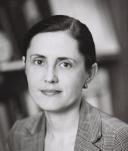 |
Other publications by this author
|
|
|
DOI: 10.7256/2585-7797.2023.1.40375
EDN: OIVKSG
Received:
05-04-2023
Published:
25-04-2023
Abstract:
The article presents the results of a project to create virtual models of architectural monuments of the Vasilevo Landscape Museum-Reserve in the Tver region with their subsequent 3D printing and creation of a large-scale layout. The Vasilevo Museum-Reserve is located on the territory of the Lviv estate of the XVIII-XIX centuries and includes manor buildings, as well as 16 monuments of wooden architecture of the XVIII-XIX centuries, brought and installed on the territory of the reserve of their various districts of the Tver region. Among them are objects of cultural heritage of federal significance: wooden temples, monuments of civil development. The museum is a branch of the Tver State United Museum and is included in the tourist route "Pushkin Ring of the Upper Volga region". As a result of the authors' project, virtual models and large-scale physical models of 19 architectural objects of the Vasilevo Museum-Reserve were made. Photogrammetry, polygonal 3D modeling, FFF 3D printing, and layout technologies were used in the work. The process of photographing to create a digital model using photogrammetry technology was carried out using a professional UAV and a SLR camera. The main software was Blender, Autodesk Meshmixer, Agisoft Metashape. The experience of digitizing objects has shown that photogrammetry makes it possible to capture fine details well in a computer model, which can be further reflected in large-scale models with 3D printing. In particular, these are wooden walls and ceilings of various designs, masonry, engraved images and inscriptions on stone. 3D printing was carried out on Creality Ender 3 and Creality Ender 5 3D printers. The printing material was polylactide plastic. The printed models were painted and reinforced in the form of a scale model. The finished model was transferred to the Vasilevo Museum and is used for museum display.
Keywords:
architecture, virtual model, 3D modeling, 3D printing, museum, model, wooden architecture, photogrammetry, digitization, Tver region
This article is automatically translated.
You can find original text of the article here.
Computer modeling technologies have been increasingly used in the study and preservation of architectural monuments in recent years. Virtual reconstructions are not only the result of actual research tasks, but also a way to preserve information about objects that have already been lost or have such a perspective [5]. The prospects of using virtual models in the presentation of museum expositions were demonstrated [4]. Various hardware and software are used to create computer reconstructions of architectural objects. In our opinion, the use of computer modeling technologies is especially relevant in relation to monuments of wooden architecture. They are the most vulnerable among architectural objects of cultural heritage [1]. For the Tver region, the topic of preserving wooden architectural monuments is more relevant than ever. There are works of historical wooden architecture, civil and ecclesiastical, which are not put under state protection, or have only the status of identified objects of cultural heritage. At the same time, there is information about the loss of such monuments. So, in 2008, the Tver Region adopted the law "On the regional target program "Preservation of monuments and traditions of folk wooden architecture of the Tver region for 2008""[8]. It was supposed to increase the identified and recorded monuments of wooden architecture by 20 units. The program provided for carrying out expeditions to identify and fix the monuments of wooden architecture in the north-eastern part of the Tver region; the formation of a data bank on objects of wooden architecture about the condition of the object, the user, the form of ownership, repair and restoration work performed. At the same time, the document stated the loss of 51 monuments of wooden architecture in the Tver region. These losses continue at the present time. Scientific research of monuments of wooden architecture can also not be called numerous. According to A.B. Bode, the wooden architecture of the Tver region has never been studied specifically[3]. Taking into account the above circumstances, the creation of a bank of computer models of monuments of wooden architecture of the Tver region seems relevant. The first approbation of this task was carried out for the objects of the architectural and ethnographic open-air museum "Vasilevo" in the Tver region. This article presents the main results of the implementation of this project. It was established in 1976 on the territory of the Lviv family estate, on the Tvertsa River (a tributary of the Volga) in the vicinity of Torzhok. In the first half of the 1970s, several expeditions were organized to the Tver region, the purpose of which was to search for preserved monuments of wooden architecture. In 1973-1974, the team of authors, consisting of A.V. Opolovnikov, A.I. Kustov and I.N. Shurgin, based on the results of reconnaissance trips, developed a preliminary draft of the first master plan of the Kalinin Regional Open-air Architectural and Ethnographic Museum in the village of Vasilevo, Torzhok district [2]. On December 13, 1976, the Kalinin Regional Executive Committee decided to create an open-air architectural and ethnographic museum, and on May 17, 1977, it was decided to allocate a land plot for a museum. By 1978, A.I. Kustov had developed the first general plan of the museum and transported the first exhibit of the museum – the Transfiguration Church (1732) from the village of Spas-na-Sozi, Kalininsky district. 22 objects were previously planned for transportation to the museum territory, which were supposed to be placed in accordance with the general plan in four zones – northern, western and Karelian resettlement zones: southern and eastern. According to the results of the expedition surveys of the Tver Region by 1982, 10 objects were transported to the museum territory, including two churches, a fire station, a windmill and a watermill, residential buildings and outbuildings. From 1985 to 1990, the development of the master plan and the conduct of a comprehensive survey of the territory of the Tver region was carried out by the Faculty of History of Gorky State University under the leadership of F.V. Vasiliev. Based on the results of the expedition survey, a new master plan was developed (taking into account the first master plan), which already assumed six zones in its structure: eastern, northern, Seliger, Karelian, southern and Penovskaya. Master plans of the Karelian and eastern zones of the museum have been developed. As a result, 80 objects of various purposes were to be located on the territory of the museum. Already at that time it was stated that the existing territory of the museum was not enough to accommodate the buildings planned for transportation. Currently, the museum is a branch of the Tver State United Museum. It is included in the tourist route "Pushkin Ring of the Upper Volga region", which includes Tver, Staritsa, Torzhok, as well as cultural monuments located in the district of the main points of the route [9]. Briefly, the monuments of wooden architecture that are part of the Vasilevo Museum-Reserve are described in the Vasilevo guidebook[7]. Information about the composition of monuments of wooden architecture in the Vasilevo Museum-Reserve is contained on the museum page on the website of the Tver State United Museum [2]. Currently, the museum complex includes 16 monuments (19 objects). Objects of cultural heritage of federal significance among them are the Transfiguration Church of the Churchyard of the Savior on Sozi (1720s), the Mikhailo-Arkhangelsk Church from the village of Maksimovskaya Udomelsky district (1760), Znamenskaya Church from the village of Pylevo Vesyegonsky district (1742). the Church of the Assumption of the Mother of God from the village of Findiraevo Vyshnevolotsky district (1800-1825), a fire station from the village of Laptikha (built in 1912, Bezhetsky district). The museum exposition includes a Karelian house and a barn from the village of Pyleva (Vesyegonsky district), a barn and a watermill from the village of Ustye (Udomelsky district), a barn from the village of Poreevo (Vesyegonsky district), etc. Relatively recently, two chapels were moved to the museum, their place of origin and dating are not indicated for them. The museum complex also includes three stone crosses and boulder tombstones with engraved images of the Late Middle Ages and Modern Times. On the territory of the estate there is an arch bridge, built according to the project of N.A. Lvov from boulders held by gravity, which became known as the "Devil's Bridge". The wing of the Lviv-Tsvylev estate of the first half of the XIX century, which was used as a greenhouse, has been preserved (Fig. 1). 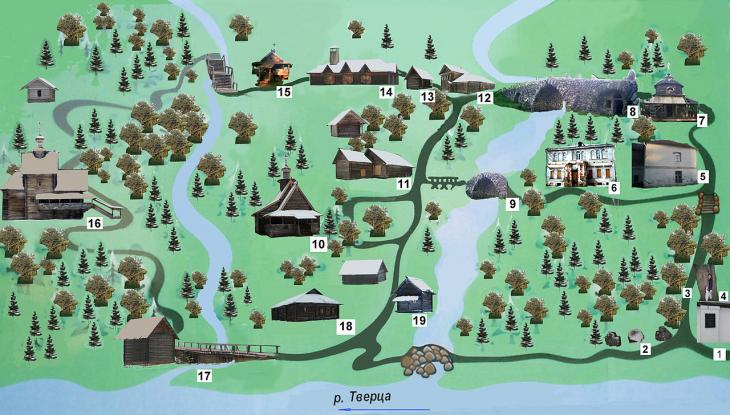
Fig. 1. Schematic map of the architectural and ethnographic open-air museum "Vasilevo" (Tver region). Despite the protected status, the monuments of wooden architecture of the museum are at risk. So, in 2013, the roof of the Fire Station facility from the village of Laptikha collapsed [6]. It was subsequently restored.
As a result of the implementation of this project, 19 objects of the museum complex were digitized, including not only monuments of wooden architecture, but also stone historical objects. In the project to create computer models of architectural objects of the Vasilevo Museum and their subsequent manufacture, the following technologies were used: photogrammetry, polygonal 3D modeling, FFF 3D printing, layout. The process of photographing to create a digital model using photogrammetry technology was carried out using a professional UAV – a "flying camera" and a SLR camera. Photography from the ground accounted for about 60-70% of the total volume of photographs, aerial photography – 30-40%. Quantitative indicators for creating a model can be characterized as follows on the example of the object "Wing of the estate of the Lviv-Tsvylev (first half of the XIX century), former greenhouse": the number of photographs – 466; the number of points of a sparse cloud – 1,500,000; the number of points of a dense cloud – 243,000,000; the number of polygons of the model – 16,200,000; the calculation time of the sparse cloud is 4 hours; the calculation time of the dense cloud is 12.6 hours; the calculation time of the polygonal model is 6.5 hours; the calculation time of the texture of the polygonal model is 1.2 hours. The time spent on creating the model depends on the equipment used, in our case – a personal computer based on GeForce GTX 1080 Ti, 64 GB of RAM, CPU AMD Ryzen 7 3700X 3.7 GHz 8 threads. The main errors in the creation of the model were free points or arrays of points not related to the object, cavities and voids associated with the possibility of free access to the survey (Fig. 2). 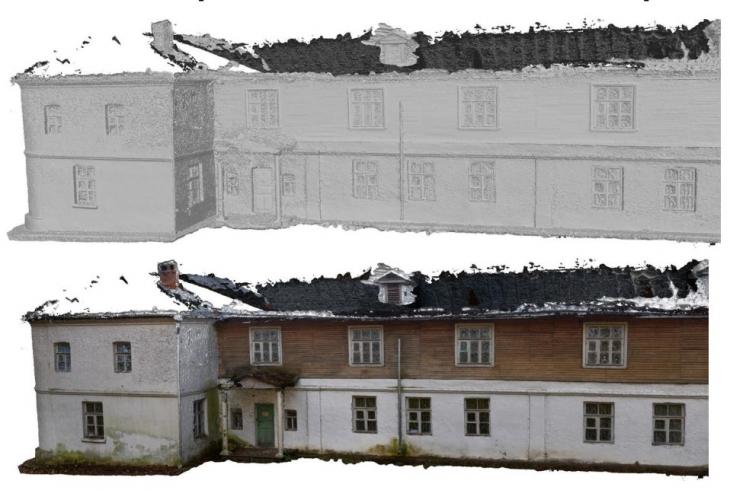
Fig. 2. Processing of an array of photographs of the object "The wing of the estate of the Lviv-Tsvylev of the first half of the XIX century, the former greenhouse". The main software was Blender, Autodesk Meshmixer, Agisoft Metashape. The experience of digitizing objects has shown that photogrammetry makes it possible to capture fine details well in a computer model, which can be further reflected in large-scale models with 3D printing. In particular, these are wooden walls and ceilings of various designs (Fig. 3, 4), masonry (Fig. 5). 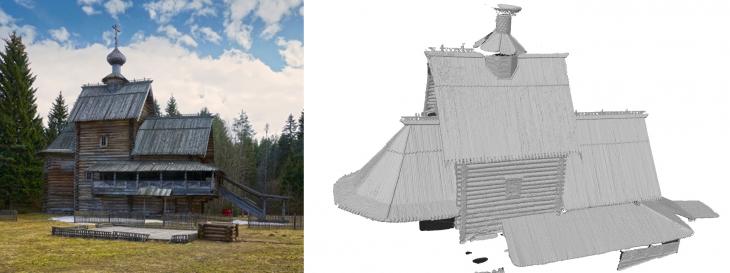
Fig. 3. The Church of the Savior on Sozi (1720s) and a fragment of the creation of a 3D model of its roof. 
Fig. 4. Church of St. Michael the Archangel (1760): a – polygonal model, b – dense point cloud, c – textured model. 
Fig. 5. Creating a 3D model of a stone bridge. The text and images on stone crosses are well displayed, which are poorly visible on the objects themselves in daylight (Fig. 6). 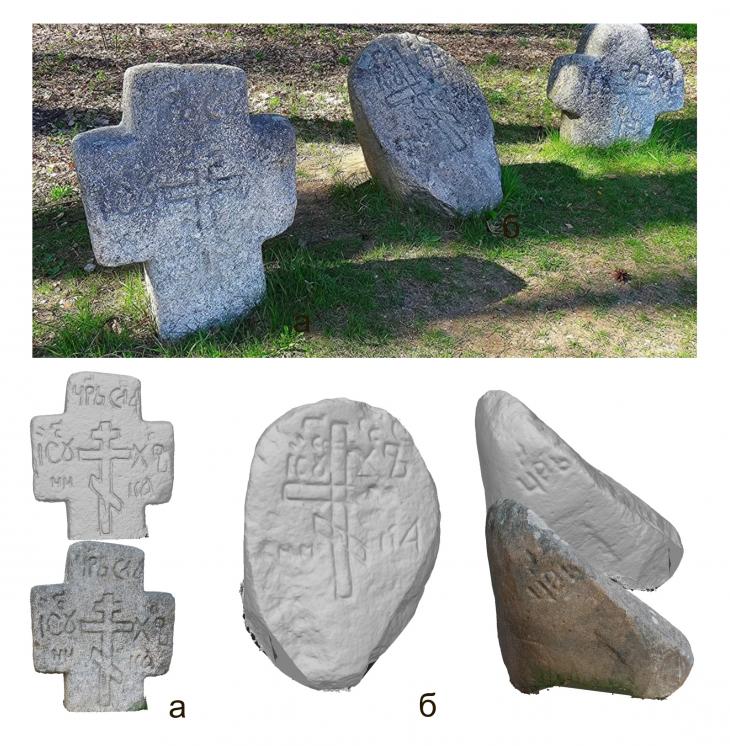
Fig. 6. Stone crosses (a) and tombstone (b) and their 3D models. It is worth noting that on the basis of the resulting scan, you can make various kinds of side content: 360 panoramas, VR/AR, renderings (visualizations) (Fig. 7). 
Fig. 7. Retopologized computer model of wooden architecture objects of the Vasilevo Architectural Museum, integrated into the Unreal Engine 5 game engine. 3D printing was carried out on 3D printers Creality Ender 3 and Creality Ender 5. The printing material was plastic polylactide (PLA). Preparation of the computer model for 3D printing took place in a specialized software – the CURA slicer. At the same time, the following parameters were adhered to: nozzle thickness – 0.3 mm, layer height – 0.15 mm, printing speed – 80 mm/sec, temperature of the extruder and table – 225 and 40?, respectively, the presence of supports – yes. The amount of material consumed and the printing time depended on the specific computer model. The main problems of 3D printing were intersecting polygons, voids in the polygonal grid – as a consequence of errors inevitably obtained when constructing a digital copy of an object using photogrammetry technology. Delicate structures were difficult to reproduce, for example, the porch railing at the Karelian house. There were also technical interruptions: clogging of the nozzle of the 3D printer, not optimal settings of the slicer, poor-quality material, power surges in the network. There were bending edges due to loose contact of the model with the table due to the complex geometry of the object; an abundance of overhanging elements. Quantitative characteristics of 3D printing on the example of the Karelian House object (Fig. 8) are as follows: 227 g of plastic was consumed, printing time – 12.6 hours, printing runs – 2 (roof and log house), post-processing time – 1.2 hours. The time spent on printing is determined by the equipment used and the settings of the slicer software. 
Fig. 8. The model of the object "Karelian house", printed on a 3D printer. Scale 1:200. The use of rapid prototyping technologies, in particular FFF 3D printing, has shown its consistency and time-consuming superiority in relation to classical methods of creating historical layouts. As a result of the project, the digitized 19 objects of the museum complex were printed on a 3D printer, painted (Fig. 9) and reinforced in the form of a large-scale layout (Fig. 10). 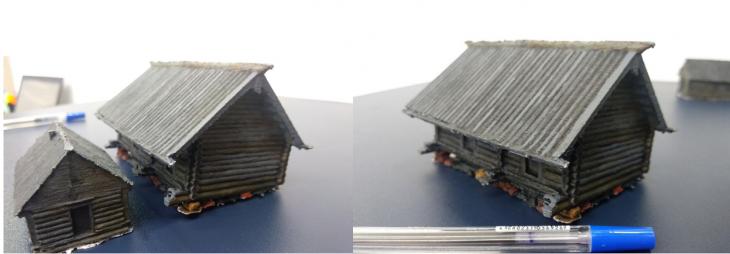
Fig. 9. Painted 3D models of the objects "Bathhouse" and "Barn", printed on a 3D printer. Scale 1:200. 
Fig. 10. Large-scale layout of the architectural complex "Vasilevo". The scale of wooden buildings is 1:200, the scale of stone crosses and boulder tombstones is 1:100. The model was donated to the Vasilevo Museum. The work experience proved to be in demand by museum specialists. A large-scale model of the architectural complex is used in an excursion display.
References
1. Anikieva, S.O. (2014). On the experience of using BIM technology for the museumification of wooden architectural monuments. In: Bulletin of Tomsk State University. Cultural studies and art history (pp. 32-36), No 1(13).
2. Architectural and ethnographic museum "Vasilevo" [Electronic resource]. URL: https://tvermuzeum.ru/affiliates/AM (date of appeal 24.03.2023).
3. Bode, A.B. (2021). Architecture of wooden churches of the Tver region. Traditions and influences. In: Architecture: heritage, traditions and innovations. Materials of the international scientific conference on March 9-10, 2021. [Electronic resource]. URL: https://archi.ru/elpub/92562/arkhitektura-derevyannykh-khramov-tverskoi-oblasti-tradicii-i-vliyaniya (date of appeal 10.03.2023).
4. Borodkin, L.I. (2015). Virtual reconstructions of historical urban buildings: new technologies for the presentation of museum expositions. In: Vorontsova E.A, Borodkin L.I., Yanovsky A.D. [Ed.]. The role of museums in the information support of historical science: a collection of articles (pp. 386-395). Мoscow: Eterna.
5. Borodkin, L.I., Zherebyat’ev, D.I. (2012). 3D modeling technologies in historical research: from visualization to analytics. In: Historical informatics (pp. 49-63), No 2.
6. A fire station collapsed in Vasilevo – an architectural monument of federal significance. In: Tver vaults. [Electronic resource]. URL: http://tversvod.ru/event120/ (date of appeal 12.03.2023).
7. Verkhov, P.I. [Ed.] Vasilevo. Guidebook (2019). Мoscow.
8. The law of the Tver region "On the regional target program “Preservation of monuments and traditions of folk wooden architecture of the Tver region for 2008 “" [Electronic resource]. URL: https://docs.cntd.ru/document/499306404 (date of appeal 12.03.2023).
9. Bozyrev, V. S., Volovich, N. M., Kezina, T. N., Likhachev, D. S. [Ed.]. Pushkin places in Russia: a guide (1984). Мoscow: Profizdat.
Peer Review
Peer reviewers' evaluations remain confidential and are not disclosed to the public. Only external reviews, authorized for publication by the article's author(s), are made public. Typically, these final reviews are conducted after the manuscript's revision. Adhering to our double-blind review policy, the reviewer's identity is kept confidential.
The list of publisher reviewers can be found here.
3D modeling and 3D printing technologies in the preservation and popularization of architectural monuments of the Vasilevo Museum-Reserve (Tver region) Journal: Historical Informatics Review The subject of the research presented in this article is the application of computer modeling technologies to monuments of wooden architecture. These heritage sites are the most vulnerable, and many are in disrepair or have already been lost, so the use of virtual models in the presentation of museum exhibitions has great prospects. The author emphasizes that the topic of preserving wooden architectural monuments is more relevant than ever for the Tver region. This is due, among other things, to the fact that many of the existing works of historical wooden architecture in the region, civil and ecclesiastical, are not put under state protection. The process of losing this part of the region's heritage continues. Based on the material of the Vasilevo open-air architectural and Ethnographic Museum in the Tver region, the process of creating a bank of computer models of wooden architecture monuments is demonstrated. Methodologically, the author strives to combine developments from the field of cultural history and historical informatics. The article uses scientific methods to analyze the value of heritage sites, as well as specific 3D modeling methods. The relevance of the work is already visible from the formulation of the topic. Using the example of the Vasilevo Museum complex, a solution to the complex problem of preserving vulnerable cultural heritage sites and reconstructing lost monuments in order to include them in museum exhibitions is presented. The solutions proposed by the author can be useful in the work of historical, architectural and ethnographic museums. The scientific novelty of the work is determined by the proposed method of creating computer models. The methods of solving the problems that inevitably arise when constructing a digital copy of an object using photogrammetry technology are also investigated. The author's method has shown its consistency and time-consuming superiority in relation to classical methods of creating historical layouts. The style of work meets the requirements of a scientific approach to the presentation of research results. It is characterized by logic, strict consistency of presentation, semantic accuracy, informative saturation, and objectivity. The structure of the presentation does not cause complaints and is characterized by the interconnectedness of the parts, the logical transitions from one section to another. The text is accompanied by a large number of illustrations that allow you to trace the progress of work on creating models. In terms of content, this article is a logically completed study of an urgent problem, carried out through the use of a set of scientific methods. The article contains a reasoned assessment of existing methods, and an author's solution to the problem is proposed. As a result of the implementation of the author's project, 19 objects of the museum complex were digitized, including not only monuments of wooden architecture, but also stone historical objects. The practical significance of the presented article is beyond doubt. The work experience turned out to be in demand by museum specialists – the created layout is part of the Vasilevo Museum exposition and is used in an excursion display. The bibliography includes 9 sources devoted to the history of simulated objects on the territory of the museum, as well as the problems of 3D modeling of architectural monuments. As a comment, it can be noted that there are no references to foreign experience. The article undoubtedly has practical value and will also arouse the interest of a wide range of readers.
Link to this article
You can simply select and copy link from below text field.
|
|




